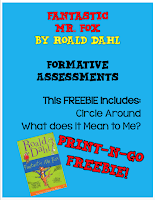Why Formative Assessment
 Let’s face it – most students hit a point – around fourth
grade – when they would rather interact with each other – than their teacher.
Gone are the days of unconditional primary school love for us – and that is
perfectly normal. Perfectly normal and a great way to engage them in formative assessment without them even knowing you are assessing.
Let’s face it – most students hit a point – around fourth
grade – when they would rather interact with each other – than their teacher.
Gone are the days of unconditional primary school love for us – and that is
perfectly normal. Perfectly normal and a great way to engage them in formative assessment without them even knowing you are assessing. Fish! Play and Your Classroom
Fish Play! taps into students' natural ways of being creative, enthusiastic and having fun. Play is the spirit that drives the curious mind, as in “Let’s play with that idea!” It’s a mindset you can bring to everything you do. (Fish! For a School Culture Checkup!)
This can be accomplished in a number of ways:
Circle Around Formative Assessment
Circle Around: A "Circle Around" is a game-type of activity that engages students by having them practice asking questions of one another. It is a great tool to use as formative assessment and it is easy.
Circle Around Goal: Make sure students understand an assignment or comprehend a reading and then produce work that demonstrates student knowledge.
Circle Around Goal: Make sure students understand an assignment or comprehend a reading and then produce work that demonstrates student knowledge.
- Print out the Circle Around form and use it to formulate questions students should know after they've read a certain passage, completed an assignment etc.
- Copy and distribute Completed Circle Around form to students.
- Explain what the students are going to do - telling them to be prepared for one person in each pair to answer out after each round.
- Divide the class into two equal groups. If there is an odd person out have that student be your helper and rotate them in after a few gos.
- Have each group circle up - one inside of the other. Instruct the inner circle to walk clockwise and the outside circle to walk clockwise until you give a predetermined signal.
- Like in musical chairs, vary the time between signals, so they can't predict when they'll have to stop.
- When the signal sounds, something even as simple as turn - have students in the inner circle turn to face someone in the outer circle - that is their partner for the first round.
- Repeat the activity until all of your questions are answered.
What You Should Look For:
- Individual student understanding - and patterns for group understanding or misunderstanding.
Carry around a class list or gradebook (or a gradebook page from your computer and use it to check off what you hear and don't hear).
Important - the point of formative assessment is to formulate a plan to either move forward or work on reteaching any deficiencies you find.
Bonus - Extra Uses:
- Use this activity when wriggly students have been seated for a long time.
- Early finishers - have them come up with questions
- Save paper - use as an oral assessment and post questions on board
Remember: learning isn't a race to the finish - if most of the students or even over 1/2 don't understand - reteach - using a different strategy. I will say it again - using a different strategy; because if the way you taught it the first time didn't work - why would it work a second time. If you need help figuring out a way to re-teach - I doubt you do - but if it is just one of those lessons - email elizabethpinotti@gmail.com for a 24 hour turn around.
Thanks for reading,
Elizabeth
See Samples:
- ON TES Fantastic Mr. Fox, by Roald Dahl - Formative Assessments FREEBIE
- ON TeachersNotebook Fantastic Mr. Fox - Formative Assessment FREEBIE
Please follow me:
TeachersNotebook: https://www.teachersnotebook.com/shop/eac913
Pinterest: https://www.pinterest.com/epinotti/boards/
Twitter: https://twitter.com/chapinpinotti
Google +: https://plus.google.com/u/0/
Facebook: https://www.facebook.com/ReadingAllAround/
Thanks for Reading,
Elizabeth Chapin-Pinotti
#ChapinPinotti
Thanks for Reading,
Elizabeth Chapin-Pinotti
#ChapinPinotti




No comments:
Post a Comment